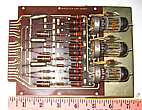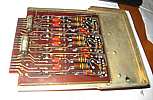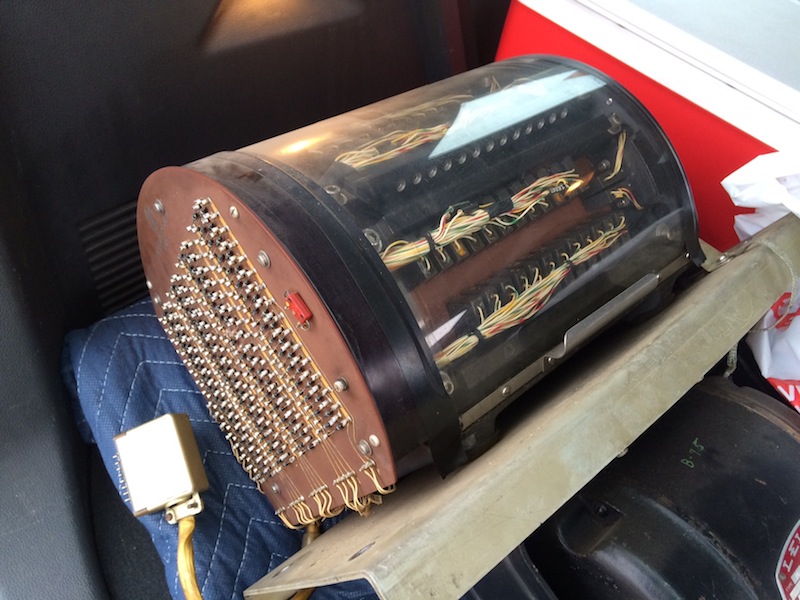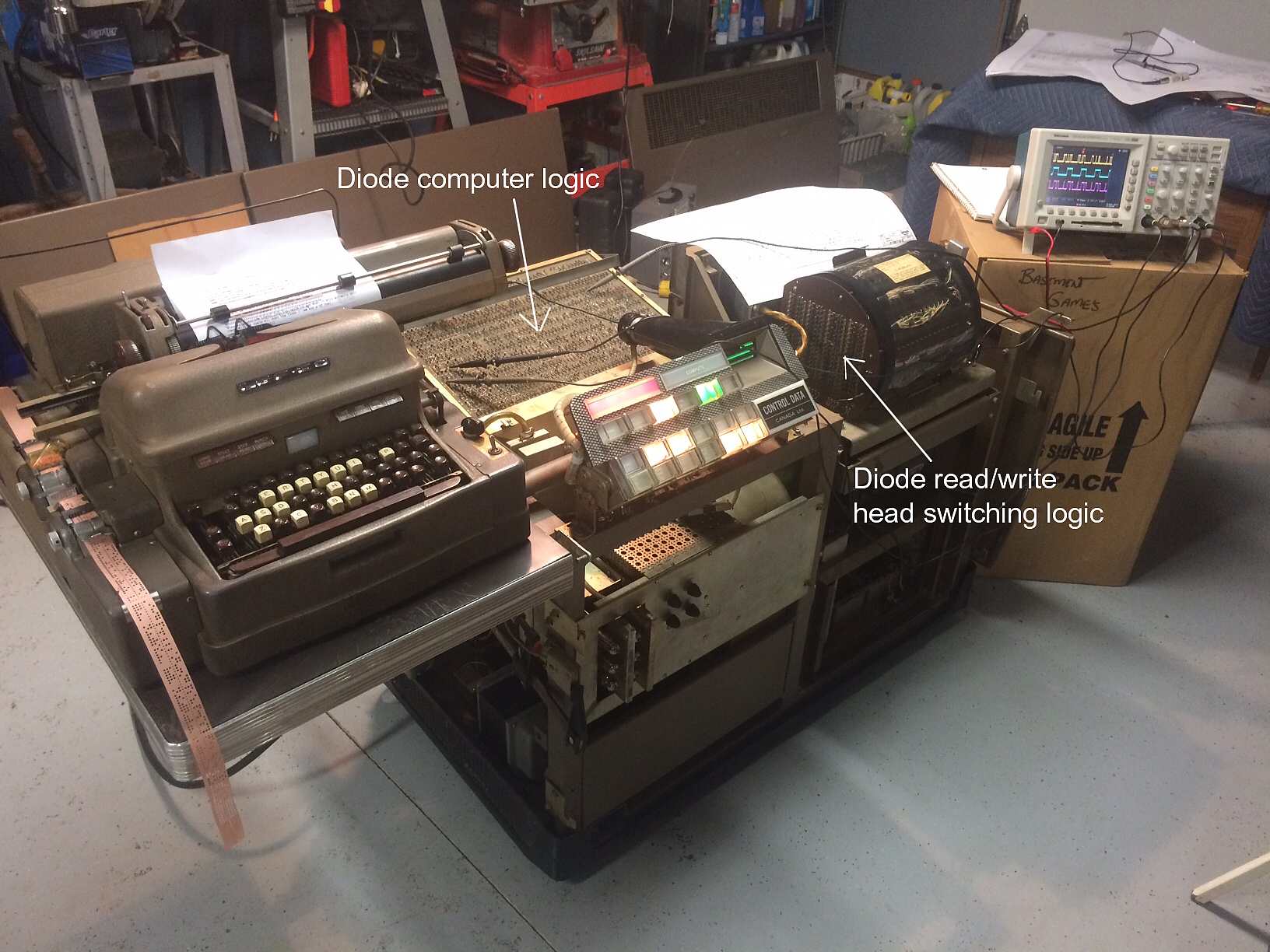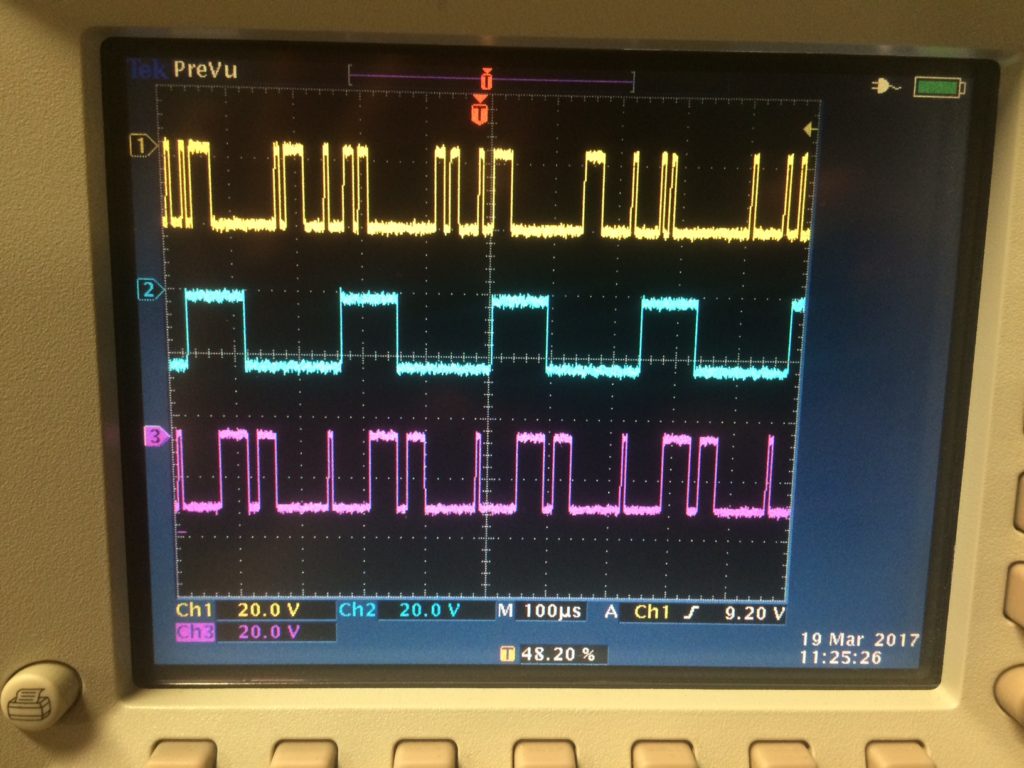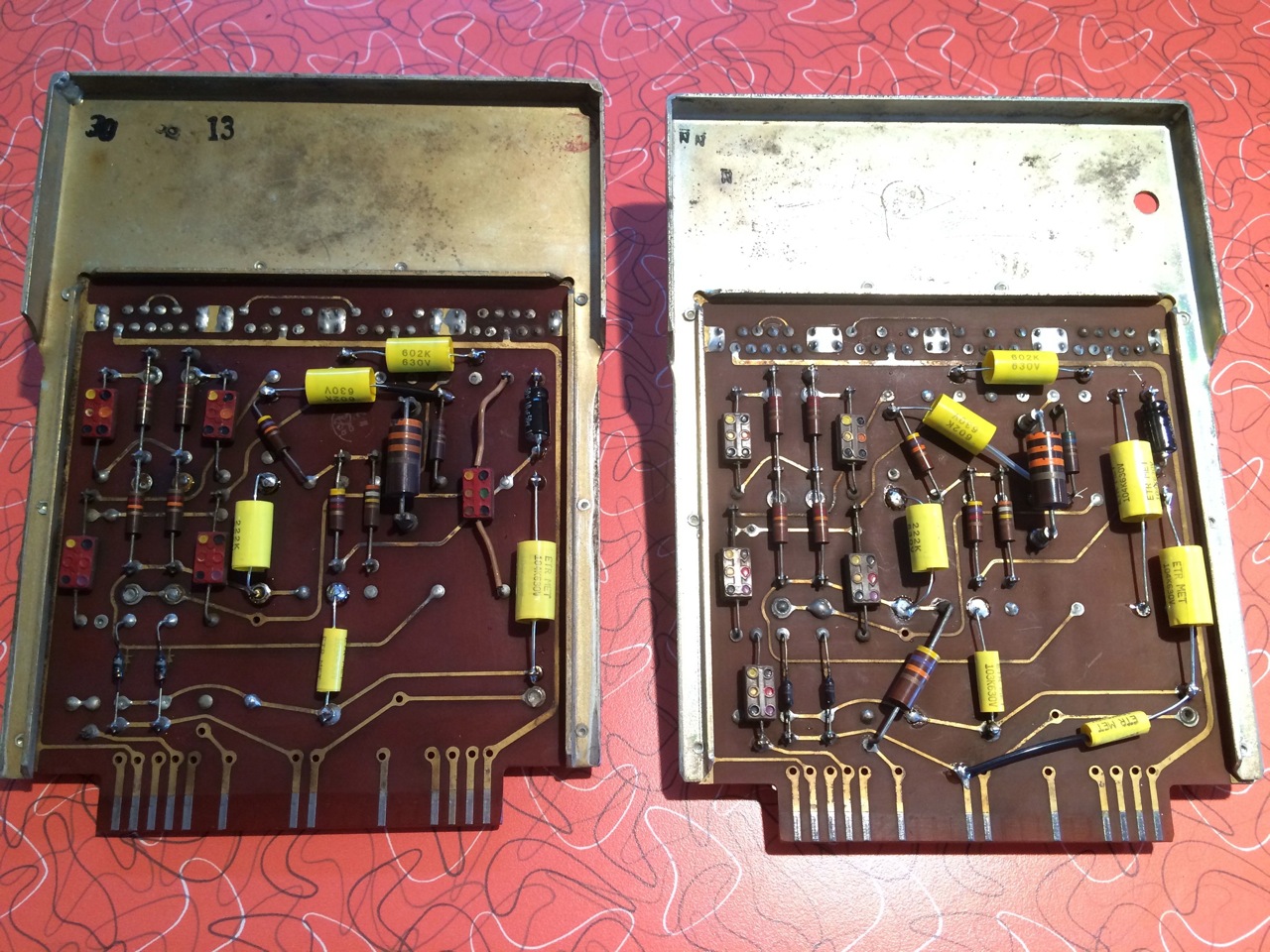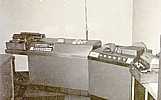Return to "Visible Storage"
*** Please note: This website (comp-hist) was completed before I found out about Wikipedia in 2002.
Since then I have added material occasionally.
Items are certainly not complete, and may be inaccurate.
Your information, comments, corrections, etc. are eagerly requested.
Send e-mail to Ed Thelen. Please include the URL under discussion. Thank you ***
Warning - a tirade follows -
I love Wikipedia. Give it over $100/year. Use it a lot -
BUT - for better or worser,
it lets seemingly any "idiot" update its web pages.
On Sept 19,20221, in https://en.wikipedia.org/wiki/LGP-30#Design was the sentence
"It also had an integer multiplication but, because the accumulator had 32 bits while memory words had only 31 bits, only even integers could be thus represented."
This "old wives tale" pops up now and again.
The "32 bit accumulator" is one of the recirculating registers on the drum, and has 31 used bits just as any other drum resident.
You can as a matter of fact multiply odd integers naturally.
This idiot removed the quoted sentence - lets see if some other idiot adds it back in ??Latest addition - DICTATOR - Wed 8/11/2021
LGP-30
Manufacturer Royal Precision Electronic Computer Company Identification,ID LGP-30 (Librascope General Precision) Date of first manufacture 1956 Number produced about 500 (Professor Smilie) Estimated price or cost $47,000 - see Dartmouth College Price Contents of this page:
- Photo
- Placard
- Architecture
- Special Features
- Historical Notes
- This Artifact
- Interesting Web Sites
- Other information
from Placard in Computer History Museum (2008)
"The LGP-30 was a small drum-based computer marketed to engineering, scientific and educational users. Among the first desk-sized computers, the LGP-30 offered small-scale scientific computing for a relatively low price. It had 113 vacuum tuves and 1,450 diodes, used conventional office power and required no air conditioning. The machine proved to be very reliable and many LGP-03s were in use fo over a decade. "Speed: 500 Add/s "
from 1981 inventory of Computer History Museum
LGP-30 - Librascope General Precision Computer Word Length: 31 Bits, including a sign bit, but excluding a blank spacer bit Memory Size: 4096 words Speed: 0.260 milliseconds access time between two adjacent physical words; access times between two adjecent addresses 2.340 milliseconds. Clock Rate: 120 Khz Power: 1500 watts Arithmetic element: Three working registers: C the counter register, R the instruction register and A the accumulator register. Instruction format: Sixteen instruction using half-word format Technology: 113 vacuum tubes and 1350 diodes. Number Produced; 320~493 First Delivery: September, 1956 Price: $47,000 Successor: LGP-21 Achievements: With the Bendix G-15 the first of the desk-sized computers offering small scale scientific computing. Revolutionizing the computer industry with the potential for low-cost distributed processing.
Description from BRL - REPORT N0. 1115, MARCH 1961
Bit serial, binary, 31 bit word computer with 4096 word drum. (Many references refer to the LGP-30 as having a 32 bit word. However, the 32nd bit is always read from the drum as a zero, so let us clarify and say 31 useful data and instruction bits.)
Standard inputs were the Flexowriter keyboard and paper tape (10 6 bit characters/second). The only printing output was the Flexowriter printer (typewriter, 10 characters/second). An optional higher speed paper tape reader and punch was available as a separate peripheral.
Interesting address location (successive addresses on drum are 7 physical locations further on) helped reduce rotational latency for instruction access. (Instructions with out memory operands could be executed much faster than one per drum revolution.) This is now called "interlacing" and is discussed in The LGP-30 and LGP-21
There were 32 bit locations per drum word, but only 31 were used, permitting a "restoration of magnetic flux in the head" at the 32nd bit time. (I never understood why the 32nd bit was not used for parity checking - there was no drum validity checking.) A utility could be run to map defective locations on the drum, and advise users and loaders of the defective tracks, but marginal and failing drums caused interesting problems.
From Joseph H. Austin Computer Science, St. Augustine's College, Raleigh NC - August 2003
I found the reference elsewhere, and thought you might like to add it [or copy of the paper if you can get it] to your site: REF: Stanley Frankel, The logical design of a simple general purpose computer, Trans.I.R.E. Professional Group on Electronic Computers, EC-6/1, Mar 1957
This paper describes what became the LGP-30 from the architectural point of view, and includes the complete boolean logic formulas for all the operations.
As a graduate student in computer science at U North Carolina Chapel Hill in the late 60's, I was taking a computer architecture class under Dr. Fred Brooks [IBM/360; The Mythical Man-Month]. He assigned each student to read the paper and work through one of the instructions, cycle by cycle and bit by bit. As I recall, I did multiply. For anyone interested in understanding the workings of a computer from the AND/OR/NOT level up, this [is] the one paper to study.
In Dec 2019 I found the following:
This website provides a link to the PDF of Stanley's paper. local PDF of from that web site.Also a local copy of a paper referencing the above here by Keith Smillie - "Programming Then and Now: From the LGP-30 to the Laptop"
from LGP-30 PHYSICAL DESCRIPTION LGP-30 PHYSICAL DESCRIPTION
The LGP-30 is commonly referred to as a desk computer. Obviously, this phrase originated because the size of the LGP-30 closely parallels the size of a standard office desk. The LGP-30 is 26" deep, 33" high, and 44" long, exclusive of the typewriter shelf. The computer weighs approximately 800 pounds and is mounted on sturdy casters which facilitates movement of the computer.
...
Another asset in regard to the computer's mobility is its power requirement. The LGP-30 requires 1500 watts when operating under full load. The power inlet cord may be plugged into any standard 115 volt 60 cycle single phase line. The computer contains internal voltage regulation of all voltages against power line variations from 95 to 130 volts. In addition to regulation of power line variations, the computer also contains the circuitry required to permit a warm-up stage. This warm-up stage minimizes thermal shock to tubes and insures long component life. The computer contains its own blower unit and directs filtered air, through ducts, to tubes and diodes, in order to again insure long component life and proper operation. No expensive air conditioning needs to be installed ,if the room is kept within a reasonable temperature range.
The computer contains 113 electronic tubes and 1450 diodes. The 113 electronic tubes are mounted on 34 etched circuit pluggable cards which also contain associated components. Although 34 pluggable cards are used, there are only 12 different types of such cards. Card-extenders are available to permit dynamic testing of all machine functions. Six hundred and eighty of the 1450 diodes are mounted on one pluggable logic board. This logic board may be quickly removed and is very accessible for service personnels use.
The main memory consists of a magnetic drum that contains 4096 words. An instruction or data word may be stored in each one of the 4096 available words. When instructions are placed on the drum, they will be executed in sequence until one of the instructions "transfers control" to a new set of instructions.
The LGP-30 had 16 instructions
OP-CODE SYMBOL FUNCTION || OP-CODE SYMBOL FUNCTION
||
0000 Z STOP || 1000 P 0001 B BRING || 1001 E EXTRACT 0010 Y STORE ADDRESS || 1010 U UNC-TRANSFER 0011 R RETURN ADDRESS || 1011 T TEST 0100 I INPUT || 1100 H HOLD 0101 D DIVIDE (rounded) || 1101 C CLEAR 0110 N MULTIPLY || 1110 A ADD 0111 M MULTIPLY || 1111 S SUBTRACT
http://computermuseum.informatik.uni-stuttgart.de/dev_en/lgp30/lgp30_1.html
states "Each opcode is represented by a letter. The binary code of the instruction corresponds to the code of the letter of the flexowriter with the two most significant bits being ignored. The ASCII wasn't invented, yet. The keyboard on the picture shows 16 white keys: these are the letters assigned to an opcode.The LGP-30 had a "Pseudo" 32 bit accumulator which was stored on the drum memory. Actually it had 32 such accumulators on one track of the drum and in the multiplication functions a 64 bit product was stored. The 'M' or 0111 multiply would give you the first 32 bits of the product while the 'N' or 0110 multiply would work the last 32 bits.
All calculations were in pure binary. Real values were faked as integer and the programmer had to take care of the bit point or the 'Q' for each value.
There was a small CRT display which was used for debugging. The display was in binary and consisted of three registers. {To read you counted the ups and downs of the trace.}
Location Counter
from Ed Thelen
Last Instruction executed
AccumulatorThis machine was about as serial as possible, The accumulator and (? other registers ?) were recirculated on the drum. To ADD from (drum) memory to the accumulator, the machine would wait until the (drum) memory rotated to the desired location, then add, bit-by-bit read/writing from/to the accumulator.A neat trick was the hardware optimization data/instruction locations.
The 31 bit signed data word could handle the range of +- 536,870,911. The floating point format used in floating point subroutines, an arithmetic interpreter, and the ACT-III compilier handled the range of
Oddly, the floating point format did not exactly represent the number 1.
0.10000002 <= |n| <= 0.9999999994
with an exponent of
-32 <= e <= +31- and
The LGP-30 did not have an index register, not indexing capability. This limitation made self-modifying code (a current no-no) a requirement. To search a list of words, part of the program loop modifies the address part of the "bring from memory" - "b" instruction. Indeed, there is a special instruction to change only the address part of an instruction so that you are less likely to make a mistake.
- and
The LGP-30 divide rounds the quotient and can cause problems.
No instruction yields the remainder of a divide, it must be calculated
The following can detect if a rounding has occurred.
"DND" is dividend, "DVR" is divisor, "QNT" is quotient, "RMD" is remainder
assuming all above input values are positive
RMD = DND-(DVR*QNT)
if ((RMD) < 0) {
"rounding has occurred"
subtract one from QNT
recompute RMD = DVR + RMD
}from Ray Borrill
There is one thing you did not mention in your list of [optional] goodies for the computer. That is the "high speed" tape reader and punch. The reader ran at 60 CPS and the punch at 20 CPSfrom Mark Greenia - August 2015 - see YouTube videos

Just found out what the boards are from. An early Librascope LGP-30 machine.
[??? the 2D21 thyratrons,left, are these for driving the Friden Flexowriter ???]

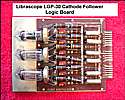
Mark Greenia kindly sent the following circuit card to Ed Thelen, as a souvenir -
A "TRIPLE FLIP FLOP 309653" - Holds three bits, all tubes are 5687. This unit uses about 25 watts.Most of the amplifier/logic tubes in an LGP-30 are:
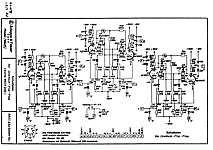
- (left circuit) Inputs C and E are edge triggered
- logic levels are clamped -20 to 0 volts, outputs B and F
- C1 and C5 are speed up capacitors
- 5687 - a miniature, medium-mu (~gain) twin triode for use in general-purpose amplifier
- 5915 - a heptode logic switching tube: both control grids at 0 V = tube conducts, control grid #1 OR control grid #3 at negative voltage: tube blocked
- 5965 - a miniature, high-mu (~gain) twin triode for use in general-purpose amplifier
Cory Heisterkamp - Dec 18, 2017
Historical Notes
from Jürgen Müller - Dec 2017 Hints from Ed Thelen
Meanwhile, here’s a little quiz courtesy of an unknown ebay seller: Which computers are behind models “A” to “D”, which Royal McBee considered to be the main competitors for the LGP-30 in 1958? ;-) Merry Christmas to everyone!
Juergen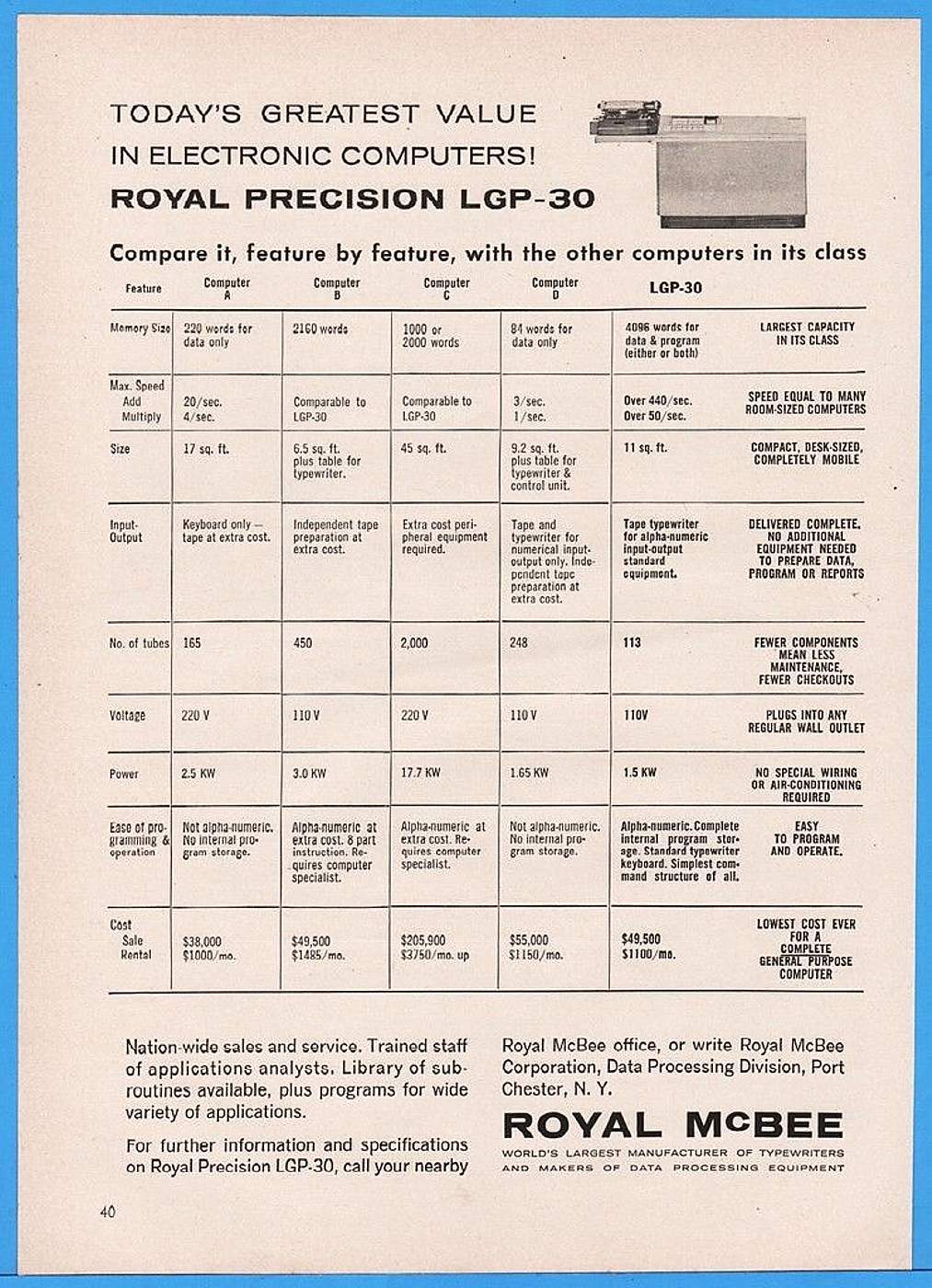
Ad
Computers available in U.S. in 1955
Computers available in U.S. in 1957
Various responses
Cory Heisterkamp Looks like Computer C is the IBM 650. I had to double check the tube count though as I couldn't hardly believe it.....2,000!!
I'm sure the Bendix G-15 fits in there, too.Jürgen Müller Agree on computer C; and B seems to be the Bendix G-15 indeed.
The rather uncompetitive-looking computer D appears to be the IBM 610:
http://ed-thelen.org/comp-hist/BRL61-ibm06.html#IBM-610
Those slow calculations and small memory did deal with 15-digit floating point numbers, to be fair... ;-)Cory Heisterkamp I'm surprised IBM ever let the 610 see the light of day. I always thought the story of how it came to be was interesting.
http://www.columbia.edu/cu/computinghistory/610.htmlfrom W Van Snyder - Feb 2017
"LGP" stands for "Librascope General Precision." Librascope was founded in Glendale, CA, in 1937, and bought by General Precision in 1941. It was bought by Singer, which was bought by corporate raider Paul Bilzerian, then sold to Loral, then Lockheed Martin. It's now Lockheed Martin NE&SS - Undersea Systems. In the 1950's and 1960's, they specialized in fire-control computers for torpedos. The LGP-30 was a general-purpose computer, not a special-purpose military computer. "LGP" was an acronymic pun, meaning both "Librascope General Precision" and "Librascope General Purpose."
In about 1961, my father was the liaison engineer from Honeywell Ordnance Division for Librascope's work on the fire-control computers for two projects, called ASROC (Anti-Submarine Rocket) and RAT (Rocket-Assisted Torpedo). He would bring home drawings the size of the dinner table, with diode gate circuits all over them, and check them. I assume I wasn't supposed to see them, but I was only 14 years old. The fire-control computers for ASROC and RAT were probably not based on the LGP-30. He told a story of a test shot of ASROC off San Clemente Island. After the shot the test torpedo was supposed to surface so they could retrieve it and use it again. It didn't, so they were sure the shot had failed and they'd lost it. Then the target diesel submarine, which had a fiberglass sail so it looked like a nuclear submarine, surfaced with the torpedo stuck through the sail. So the test worked quite well.
According to http://www.silogic.com/Athena/Athena.html (and history.nasa.gov) the computer on the Centaur upper stage was a Librascope 3, a 25-bit drum computer. Maybe it was based on the LGP-30.
Van
from David Hartke July 25, 2008
In 1962 I had the distinct pleasure to come to know Stan Frankel in a business capacity. At the time I was working for a company called CSC (Consolidated Systems Corp.) in Monrovia. A couple of us had designed a micro-programmed computer along the lines of Wilkes. I was asked to get someone to critique the design and Frankel’s name came up. I consider him to be one of the most brilliant people I have ever met. One of the things that really impressed me was his ability to approach things from basics. Not sure but I think he would often start out with “well the charge of an electron is …..”. Another thing I remember was his work on solving the detergent soap bubble problem. He and a Chinese guy (I think) wrote a book about soap bubbles and that work, at least in part, led to the design of a better detergent soap in which the soap bubbles would collapse over time so as to not plug up sewage treatment facilities. I also remember that the first day he came to meet me: he came in looking like a bum directly off the streets in downtown L.A.! I am pretty sure he had not shaved in a day or two. And to complete the picture I remember he brought in his cigarette rolling machine. Then, all during our conversation/work he would frequently stop to roll his own cigarettes. Of course, his design of the LPG30 was extremely impressive to me. I always have said that that machine was truly the first personal computer. Of course, the $10K [???] price tag probably makes some people take issue with that statement. Perhaps the main reason I wanted to write to you was to ask you how many flip-flops the machine had. My memory says there were a total of only seven, which, of course, is remarkable, if true. Could you verify that?
wikipedia says 15 - I don't have schematics - Ed Thelen
from Bill Bryner (Sept 11, 2007)
My name is James William (Bill) Bryner. I programmed the LGP-30 for Douglas Aircraft Company in 1959. That was during the testing of the DC-8. In 1960 I was hired by Royal-McBee to write the assembler for the replacement to the LGP-30, the RPC-4000. Royal-McBee was the company that produced Royal typewriters and McBee business data forms. They had joined with Librascope, a division of General Precision, to market the LGP-30 and later the RPC-4000.Steve Leibson writes [October 2004]Mel Kaye designed the RPC-4000 assembler. It was titled ROAR (Royal-McBee Optimizing Assembler Routine). Edward W. Dubbs and I programmed that assembler. Following that, I wrote an LGP-30 simulator to run on the RPC-4000. This was meant to allow all programs written for the LGP-30 to be executed on the RPC-4000 without further programming. A drum computer simulating a drum computer is agonizingly slow!
General Precision was responsible for the hardware and Royal-McBee was responsible for the programming, marketing and schooling relating to those computers. The programming offices and school of Royal-McBee were located on Cahuenga Blvd. between Sunset Blvd. and Selma Ave. They were placed there because the sales people felt the Hollywood location would attract sales by people wanting to go to school in Hollywood.
I hope this information will be of interest to you. If you have any further questions I will be glad to try to answer them.
Bill Bryner
Received Sept 5 2017
I now live in Lihue, HI and play in a big band called the Starlighters. I was just featured in a local paper: http://midweekkauai.com/pdf/2017/0726/index.html
Aloha,
Bill "Through the San Jose library's inter-library loan program, I just got a copy Stan Frankel's article on MINIAC and the LGP-30 published in the IRE's Computer Proceedings in 1956. The article states that Frankel's MINIAC was built at CIT and that it served as a prototype for the Librascope LGP-30, which has essentially the same hardware as MINIAC including the drum-memory-based register system. Does that jive with your understanding of MINIAC, Marchant Research, and Atlantic Refining? Neither Marchant nor Atlantic are mentioned in Frankel's article."For a fascinating story of designer of the LGP-30, click Stanley P. Frankel, Unrecognized Genius
"Through the San Jose library's inter-library loan program, I just got a copy Stan Frankel's article on MINIAC and the LGP-30 published in the IRE's Computer Proceedings in 1956. The article states that Frankel's MINIAC was built at CIT and that it served as a prototype for the Librascope LGP-30, which has essentially the same hardware as MINIAC including the drum-memory-based register system. Does that jive with your understanding of MINIAC, Marchant Research, and Atlantic Refining? Neither Marchant nor Atlantic are mentioned in Frankel's article."For a fascinating story of designer of the LGP-30, click Stanley P. Frankel, Unrecognized Geniusfrom Ed Thelen
It is interesting to view the web sites of early users - such as The Computer and Me and LGP-30 by Keith Smillie. The LGP-30, The University of Alberta's first computer, had no compilier and no floating point routines the early days. Using it for serious work must have been "interesting".from Kathi ColeIn college in 1959, an LGP-30 arrived with an interesting compilier called ACT-III which I used before I heard of FORTRAN. Here is the manual, copied from that wonderful bitsavers.org. When I later used FORTRAN, there was about a 1 to 1 statement similarity except for the FORMAT operations, which seemed easier in ACT-III. And ACT-III handled mixed mode (integer and floating point) much better than the FORTRAN of the day. In the early FORTRANs you had to be VERY careful about converting operands to compatable formats when you wanted to multiply a floating point number by an integer. ACT-III just went ahead and "did the right thing". FORTRAN seems to have been very user unfriendly in that respect for a long time. There was also a symbolic assembler that was convenient.
The compilier took (? 10 minutes ?) to read onto drum from the Frieden Flexowriter, but once installed was good for compile and run for days or until you loaded some other program.
The floating point was "reasonably" quick. I simulated a tube based analog multiplier (the analog multiplier used pulse width modulation) through a large variety of wave forms, frequencies relative to the pulse width frequency, and other conditions over a LONG (no sleep) weekend.
... and my dad, Charles "Charlie" Cole went to work for Louis Imm of Librascope in 1941, as a tool and die maker. He started working for Mr. Imm just after the first Glendale, CA plant location was opened, which I believe was on Sonora Street, near the then-existing Glendale Airport.... he eventually became production control manager for Librascope. I can remember him talking about the purchase by General Precision, and later by the Singer Corporation - both of which companies are now defunct, I believe.
I've been trying to trace the chronology of the company through searches on the Internet, which is how I found your site. At some point I understand Singer Corporation sold Librascope to Loral, who had it in their Federal Systems-Manassas business unit, which was then bought by Lockheed Martin in April of 1996, and in 1997 closed the Glendale facility and moved operations to Virginia, thereby ending a 50-year history of the company being a good-sized employer in the Southern California aerospace industry. If you have any resources you could refer me to for researching the last 20 years of Librascope history, I'd sure appreciate hearing from you.
This Artifact
-
- LGP-30 Supplement from an LGP-30 Maintenance Manual on line from Germany
- On-line manual LGP-30 Programming Manual by Royal McBee Corporation
- On-line manual "LGP-21 Programming Manual"
From Bob Supnk ": The LGP-21 and LGP-30 are not program compatible; not even upward or downward compatible. The LGP-21's non-IO instructions are either the same as the -30, or add some new features (like overflow flag and Z skips); but the I/O instructions are completely different. The LGP-21 has "IO device addresses" in the IO instructions; the LPG-30 has data (or nothing) in the IO instructions, and the IO device selection is done by manual switches. The -21 stalls on output; the -30 must be correctly timed or manually stalled or it will lose data."
Chapter topic TOC Table of Contents 1 Introduction to the LGP-21 2 The LGP-21 Command Structure 3 Construction of an LGP-21 Program 4 Binary Number System 5 Number Scaling for the LGP-21 6 INPUT/OUTPUT 7 Program Tape preperation 8 Timing and Optimization Appx A Computer Control Panel Appx B INPUT/OUTPUT Unit Controls Appx C Various tables
- A Working LGP-30 see restorations.html#LGP-30
An e-mail from Klemens Krause November 26, 2002 to Arnold G. Reinhold
I just found 'your' programming example for the LGP-30 written in ACT III (again): http://world.std.com/~reinhold/comp-hist/actiiisample.html
I have a running LGP-30 with some original software. For example the ACT V - compiler. I have also the ACT I and ACT V documentation and an annotation about the differences between ACT III and ACT V. So I think I can do some remarks about the programming example from Arnold G. Reinhold.
First there is a typing error in line 5: After label s2 the apostrophe is missing. (Sorry, very trivial).
Then obviously the program was not complete at compile time. The last line
daprt'p'e'r'i'o'd' 'i's'
makes no sense. This is obvious. But whats not obvious: ACT programs are finished by three apostrophs.A last line in an ACT-program thus could be
stop'''
or
use's1''' (to return to the begin.)The symbol table with the four undeclared labels s000 to s040 shows that the program was incomplete at compiletime.
Third, the line
f 0730
is not a error message, it is the last word used by the compiled program.For your further information: my german ACT I manual is printed in sept. 1961 and the ACT V manual is printed 1964. My original paper tapes are labeled 1965.
Best regards
KlemensKlemens Krause Universitaet Stuttgart / Inst. f. Softwaretechnologie Breitwiesenstr. 20-22 / 70565 Stuttgart Tel.: 0711/7816 341
- Bob Supnk writes (Jan 2004)
I'm plodding along on an LGP-30/LGP-21 simulator. Your site, and the others, have been very helpful. There was a lot more material than I expected. I even found an archive of transcribed paper-tapes, although now I can't figure out where it came from. My goal is to get Blackjack running and then leave the rest to users.
- Martin Olsiewski writes (Feb 2007)
I worked on the LGP 30 when I got out of the Marine Corps in Feb.1966 for one year. Control Data Corp. had purchased many of the "beasts" from Librascope and was refurbishing the machines for resale for approximately $10K. The mini computer was just beginning to appear (PDP 8, etal.) and pretty much ended what little future the LGP 30 had. I was always proud to say I worked on a first generation computer. I really didn't get too involved with software. This was my first real job. I was a repair man for continuous wave radar on the Hawk missile system while in the Marine Corps. Much of the work I did on the LGP 30 was stripping the cards and drum memory out of the frame, then cleaning the carcass and trouble shooting. We typically replaced the bearings in the blower and then began to reassemble the machine. The enclosure panels (skins) were sent out for paint and every drum memory was stripped of oxide and had new bearings installed. The drum had to have less than .001 inch of run-out after the bearing change, if not they were changed again until it met spec. Then the drum was painted with oxide and cured. In the mean time the mainframe was put together and tested with a place_holder drum memory without skins. After a while I had developed some pretty thick skin on my fingers replacing tubes during the testing and trouble shooting process. All the heads were then mounted on the refurbished drum and set to some head/drum spacing, I don't remember what it was, but it was close. The drum memory was then mated with a frame and the testing and burn-in began. The acid test came when we enclosed the frame with the newly painted skins. The temperature rise on the inside of that beast was pretty significant, we some times lost a drum when a head crashed and everything got reset to zero as far as the drum was concerned. Most made it out the door to some lawyer or doctors office.
- Dave Bowles writes (April 2007) ;-))
Hello Ed, I thought you might get a chuckle out of this. Sherman, set the wayback machine…
In 1967 I was 17 and I traded a CCTV camera and $150 for two LPG-30’s, a Flexiwriter, a high speed paper tape reader and a high speed paper tape punch. I was nuts about computers and could not believe my incredible good fortune to actually have my very own. I was told the units had come from John’s Hopkins University - Applied Physics Lab in Maryland where they had been used to calculate satellite orbit data until they were decommissioned. Everything had allegedly been maintained by Royal McBee and had been recently reconditioned before being put into storage for a few years before being sold as surplus.
I had no documentation or software for either of these machines and could not locate any. A tantalizing cover sheet for a piece of software called SNOBOL was all I could find. Unfortunately, the drum on one of the two LGP-30’s seized during my initial checkout. It ripped itself from the mountings (which must have been loosened) and proceeded to screech horribly and flail about tethered only by the head nest cables. The experience gave me a totally different perspective on the enormous drum memory system called a “FastRand” that I had seen at the University of MD’s computer center.
Anyway, undaunted, ignorant and determined, I got the remaining LPG-30 working using the parts (mostly dead tubes) from the other and I learned quite a bit about computers and programming in the process. Most fortunately, the Flexi and paper tape hardware worked perfectly. I scrapped the dead unit and maintained the working one for about 4 years. In the interim, I wrote a bootstrap loader, an assembler and an editor for it which made it much easier to use and involved far less eyestrain from continually aligning the accumulator trace with the printed graticle. I do not think the term ”Running Light Without OverByte“ had been coined by a not-yet-existent Dr. Dobbs Journal at that time, but I definitely got the concept.
I eventually traded the whole system to a physics student from the University of MD for $100 and a broken portable 1” Sony VCR and camera combo. Then, about 4 years after that in 1975, I ran into an LPG-30 again. It was sitting cozily in the basement of a fellow electronics entrepreneur that I was meeting for the first time. I could not believe my eyes. Here was someone else with an LPG-30! How many of the darn things were there anyway? As it turned out, this LPG-30 was indeed my old friend. He had received it free and clear when it was discarded from the physics department at the UMD. Looking more closely, there was an unfamiliar aluminum Bud box sitting on top of the drum. He told me that the drum had failed over time since he acquired the LPG-30. On a lark, he had actually designed, layed out, taped up and etched the PCB’s to construct a 2102 (1K x 1) based memory system replacement for the drum. He then turned the darn thing on and showed me that it still worked. It had been 8 years and there I was back squinting at the CRT O’Scope again and tweaking the knobs to align the trace with the tick marks. Some things change, and some things don’t.
The last I heard, that LPG-30 had gone to its final rest.
Dave Bowles
Annapolis, MD
- An adventure
e-mail from Bill Seater - Nov 2011
- A weird blunder on Wikipedia - as of Dec 27, 2016
This web page was up and running before Wikipedia really got going. see An advantage of Wikipedia is that experts can pour info into it :-))
from Main_Page - "the free encyclopedia that anyone can edit."
A disadvantage is that "experts" can do the same :-((A current (Dec 27, 2016) statement in https://en.wikipedia.org/wiki/LGP-30 is:
"It also had an integer multiply but, because the accumulator had 32 bits while memory words had only 31 bits, only even integers could be thus represented."The above would be funny on "Saturday Night Live", but is weirdly incorrect on Wikipedia.
Comment from Cory Heisterkamp < coryheisterkamp @ gmail . com > Sun, Apr 15, 2018
Jürgen_Müller sent me an early version of his series of FPGA based LGP-30 clones. More info is here.
Please excuse the "inch" scale in the photo. "Americans" insist on continuing to use this measurement system of a long dead English king, which we fired, rather the handier metric system used most other places ;-))
Now, in order to play with this, I have to remember how to think :-((
In fact, it's snowing this very minute. So what better way to spend a little time than to wrap up Jurgen's LittleGP-30 project. Electronically it was complete, but finding printable-transparencies was a tad difficult until I remembered some "official IBM" ones I had stashed away 20 years ago. Worked great! I had some scrap aluminum angle out in the shop to make a base and used a mini-disc sander to get the standoffs appropriately sized. I had the perfect vintage knob to use, but that required a little drilling-out. Added some rubber feet....Perfection! 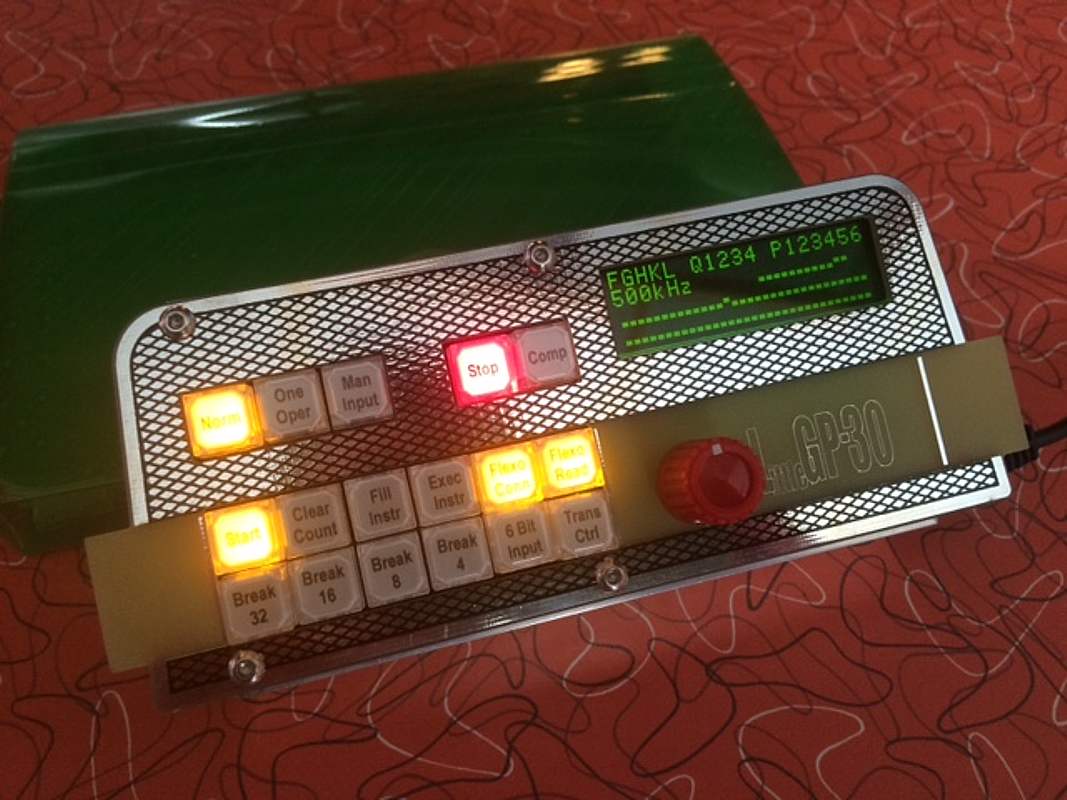
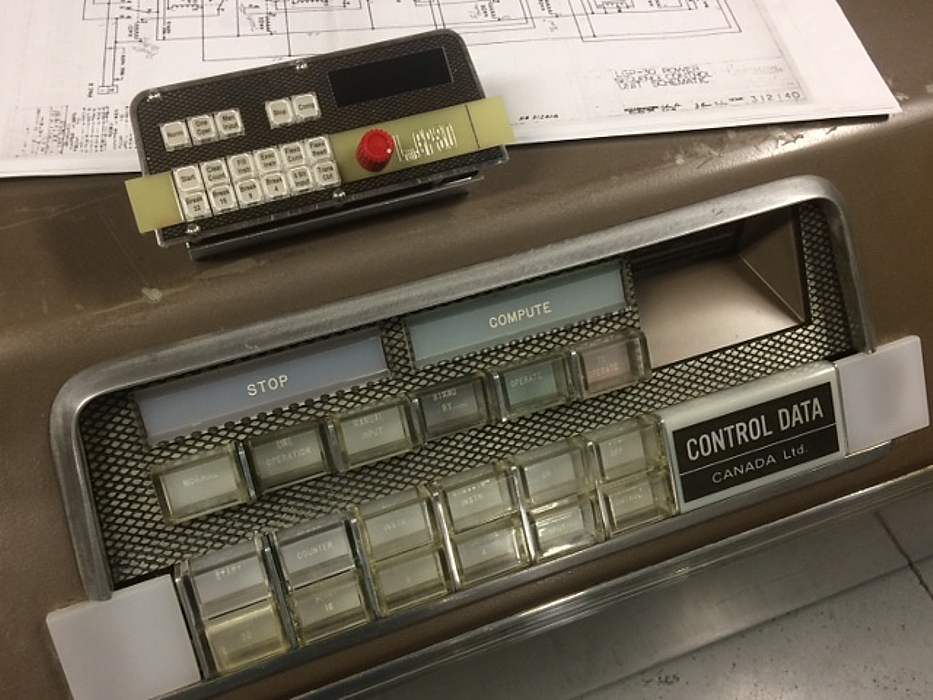
- Dartmouth College Price - from Spring Ford - Dec 2019

The video https://youtu.be/WYPNjSoDrqw?t=417 at 6m 57s in shows an Invoice for such a machine.
comment by Ed Thelen - Look, the results of an educational discount :-))
- From Stuart Olson - Wed 8/11/2021
I read with interest your history of the LGP-30. I was an early user of the computer installed at the Ordnance Management Engineering Training Agency (OMETA) on the Rock Island Arsenal, Illinois.
I quickly learned the machine language and the interpreter for solving many complex physics problems for development of large caliber howitzer systems. Then we subsequently acquired a new programming language called DICTATOR (I forgot what DICTATOR stands for). It was a massive roll of tape that took about a half hour to load through the Flexowriter, but became faster with the new optical reader. DICTATOR was a 3-address interpreter using automatic floating point math, making the LGP-30 easier for engineering work, but much slower than machine language programs.
I'm surprised you didn't mention DICTATOR in your piece.
Thelen here:
Surprise to us all - searching for "LGP-30 DICTATOR", I found useful hits.
- I copied this from
- http://bitsavers.trailing-edge.com/pdf/royalPrecision/LGP-30/en/H1-124_Oct1959.pdf
- seemingly distributed by "LGP-30 Users' Organization-Pool"Thank you.
Stuart W. Olson, PhD
2340 Wassum Trail
Chuluota, FL 32766
407-365-6836
If you have comments or suggestions, Send e-mail to Ed Thelen
Go to Antique Computer home page
Go to Visual Storage page
Go to top
Updated April 2022 - a photo added to Photo


